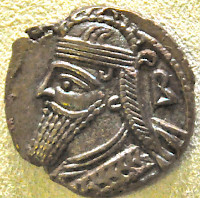Vologases IV
Vologases IV: Arsacid king of the Parthian Empire (r.147-191).

Ever since the death of Pacorus II in 105 CE, the Parthian Empire had been divided. In the western regions, Osroes I had faced the war against the Romans; although he had survived, he had lost control of the northwestern buffer states like Osrhoene and Armenia. In 129, he was succeeded by Mithradates V, who was in his turn succeeded by his son Vologases IV. Meanwhile, the eastern regions had become more or less independent under Vologases III, whose coinage continues until 147, the very year of the accession of his western rival Vologases IV.
The logical reading of the events is that Vologases IV succeeded his father and immediately eliminated his eastern competitor, but we do not know how. He also seems to have regained control of Characene at the confluence of the Tigris and Euphrates. It seems that in 161, he also wanted to increase his influence in Armenia, where the Romans always crowned the king.
Vologases attacked immediately after the death of the Roman emperor Antoninus Pius, occupied Armenia, made Pacorus king, and was able to destroy a Roman legion (VIIII Hispana or XXII Deiotariana). The new Roman emperor, Lucius Verus (brother and colleague of Marcus Aurelius), arrived in 162/163 and recovered Armenia in 163, placing another king on the throne, Sohaemus. In 164, the Roman general Avidius Cassius captured the Parthian capital Ctesiphon. The outbreak of an epidemic meant the end of the war. It seems that the Parthians in the end were victorious, because in 180, after the death of Marcus Aurelius, Sohaemus was replaced by a son of Vologases IV, Vologases V.
Towards the end of his reign, Vologases had to cope with the revolt of Osroes II. The official successor, the Vologases V who had been king of Armenia, inherited the problem.
Note
The chronology of the Arsacid kings of the Parthian Empire is less well-understood than, for example, the sequence of Seleucid and Ptolemaic kings or the emperors of Rome. This information is based on the researches by G.R.F. Assar, as published in "Iran under the Arsakids, 247 BC – AD 224/227" in: Numismatic Art of Persia (2011).